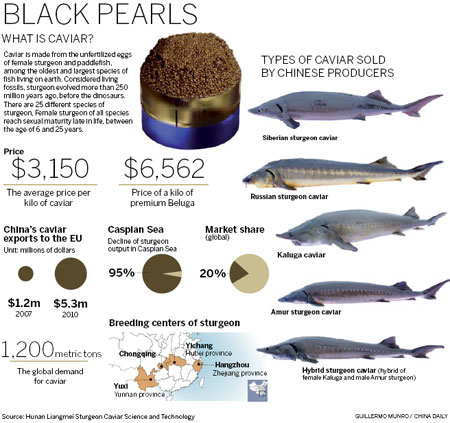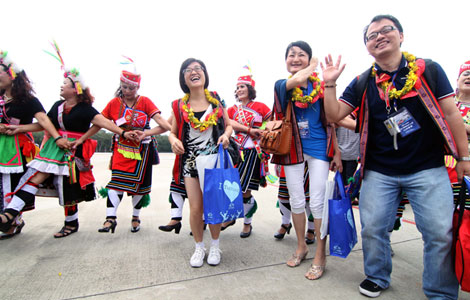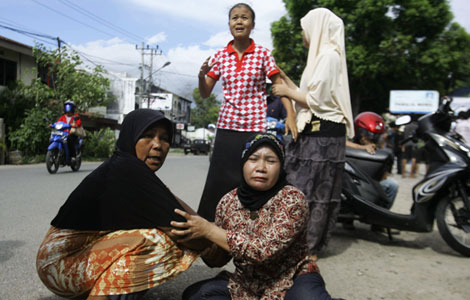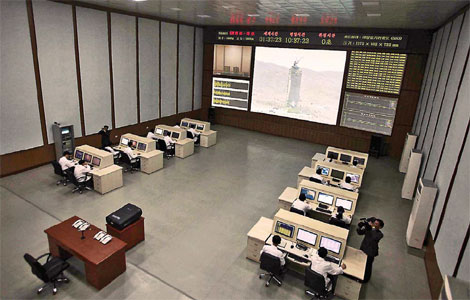 |
|
|
|
|||||||||||
Chinese caviar's success shows tide is changing in its favor, reports Wu Wencong in Beijing.
April 8 was a red-letter day for conservationists. More than 1,200 farmed Chinese sturgeon were released into the Yangtze River to increase the numbers of this rare species in the wild. One of more than 20 species, the Chinese sturgeon, or acipenser sinensis, is unique to China and has existed for more than 140 million years. It enjoys protected status and it is illegal to breed or trade it privately, let alone have one on your dining table.
However, other types of sturgeon don't enjoy such revered status in China. They are cultivated commercially for their eggs, which are known as "roe" and can be processed into caviar, one of the most valuable foodstuffs in the world. Caviar bearing the label "A Product of China" has been available since 2006.
The international trade in sturgeon-related products once relied overwhelmingly on fish from the Caspian Sea, the world's largest lake, and accounted for about 93 percent of the global caviar trade in 2003, according to data released by the Convention on International Trade in Endangered Species of Wild Fauna and Flora.
However, overfishing, rampant poaching and environmental damage have sharply reduced the numbers of sturgeon in the Caspian in recent decades, forcing devotees to look elsewhere for their favorite dish.
"Ninety nine percent of the caviar traded in the global market now comes from farmed sturgeon," said Ni Hao, founder of Lindys Foodservice Consultant and former executive chef at the China division of Unilever's food solutions department.
Insiders say that China accounts for nearly 20 percent of the sturgeon in the global market, despite its relatively brief breeding history of less than 15 years, and the country's produce can now be found in Europe, the US and Japan. It's become a stable supplier of high-end brands such as "Petrossian" of France and can also be found in the first-class cabins of international airlines.
Although China is a relative newcomer to the world of caviar production, the prices of the product culled from certain types of sturgeon are higher than those of many foreign counterparts because, unlike the majority of rivals, sturgeon in China are mainly raised in natural waters rather than the recycled variety prevalent in fish farms, leading to larger fish and bigger eggs.
"Water is a very important factor in determining the quality of caviar," said Ni. "It may taste too earthy if the water used is not of high enough quality. Larger eggs normally mean higher prices," said the 39-year-old expert.
At Thousand Island Lake, for example, the highest water temperature in summer is 33 C, far too high for at least two species raised there, the Siberian and Amur sturgeon, which require a temperature of 22 C.
The surface area of the lake is 573 million square meters, and so the fish are held in underwater cages - covering around 40,000 sq m - to ensure that they can be captured easily. Each year, as summer approaches and temperatures soar, workers at the center transfer the sturgeon from the submarine cages to a "summer resort" pool, excavated on an island in the lake. Cooler water, taken from a depth of 15 meters and averaging around 16 C, is continuously pumped into the pool.
The sturgeon usually spend around three months in the resort. "We start transferring the fish in early June so they will survive the hottest period between July and September," said Gong Liang, deputy director of the center. He said the transference of the fish is the most labor-intensive part of his job, standing in water under a sweltering sun several hours a day for a month, netting sturgeon that can easily weigh more than 100 kilograms. "It's really strenuous labor," said Gong, "But the good news is that we take a monthlong vacation once it's completed."
In 1997, researchers at the Chinese Academy of Fishery Sciences began to import tens of millions of fertilized eggs from Siberia. The same year saw the start of a program to breed wild sturgeon in the Heilongjiang River in northeast China. "The breeding project there was aimed at preserving the species," said Wang Bin, a former researcher at the academy, who was in charge of developing the method of cultivation and promoting it throughout the country.
Wang said rivers are the best places for wild sturgeon, which require a course as long as 1,000 kilometers to spawn, with the foods available in the river and the stimulation provided by the current playing an important role in the spawning process. "But, it (Northeast China) is not an ideal place to farm sturgeon, because they are kept within a restricted area," he said. "Moreover, it takes around two or three years before a sturgeon grows to more than 1 kg. In the south, the time required is just one year."
In 1999, when the breeding process first began to spread in China, sturgeon cost more than 200 yuan ($32) per kg in the markets, and more than 1,000 yuan in upmarket eateries. The average house price in Beijing at that time was just around 3,000 yuan per sq m.
However, by 2003, when an increasing number of people began to enter the industry, the price dropped to about 40 yuan per kg.
Wang saw a second chance for the industry after he investigated overseas and realized that sturgeon eggs were far more valuable than the flesh. So he left the academy in 2003 and immersed himself in the industry. Now he is the general manager of Hangzhou Qiandao Xunlong Sci-Tech Co, one of the first Chinese companies to export caviar.

"The best time to extract the eggs is during the first 11 weeks of the sturgeon's stage 4 maturity," Wang said. "This is very difficult to master. The eggs are not rich enough if extracted earlier, but they wither if taken later." It's essential that the eggs undergo 16 different processes within 15 minutes of extraction to ensure the best flavor, he said.
Unlike their Western counterparts, Chinese caviar producers operate a model that includes independent fishermen, plus breeding and processing centers, and the use of companies that sell the eggs.
Fang Xinming, a 38-year-old fisherman at Thousand Island Lake, was among dozens of fishermen that helped enterprises to breed sturgeon at an early stage in their development. In November, he bought 20,000 newly hatched sturgeon weighing about 0.1 kg each. In around three years, when the fish weigh more than 10 kg each, a processing company will buy them and continue raising them in large cages in a lake.
Fang started breeding sturgeon in 2009, when he bought just 5,000 because of concerns about the high level of investment and his limited knowledge of the fish. But now he has no concerns at all and expects to make a profit of 2 million yuan in two years.
"I've talked my two brothers into raising sturgeon this year," said Fang. "Most people are still looking on. Their eyes will pop out when they see me making all that money. What other kind of fish can bring you a profit of 1 million yuan in a year?"
Currently, there are three main companies involved in the production of caviar in China, and all have high hopes. Hangzhou Qiandao Xunlong at Thousand Island Lake started test runs at its new processing plant in Quzhou, Zhejiang province this month. When fully operational, the factory will be the largest in Asia with a processing capability of 35 metric tons a year.
Tianxia Sturgeon (Group) in Hubei province started construction of the World Sturgeon Industrial Park in Wuhan, capital of Hubei province, in 2009, scheduled for completion in 2014, with planned investment of 1.3 billion yuan.
The third company, Yunnan Amuer Sturgeon Aquaculture, attracted a large shareholder in May, and is aiming to become a first-class caviar brand in 10 years.
"The high technology threshold and the long wait before one sees a profit have prevented many people from entering the industry," said Wang Bin. "I see that as a good thing for the industry - it doesn't offer quick money, but it will grow slowly and steadily."

|

|

|

|

|

|